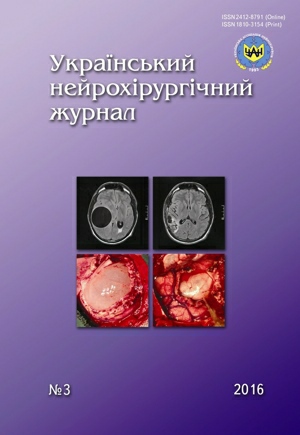Percutaneous vertebro- and kyphoplasty: a regional experience
DOI:
https://doi.org/10.25305/unj.78769Keywords:
compression fracture, vertebroplasty, kyphoplastyAbstract
Purpose of the study. Identify the dynamics of pain in patients after percutaneous vertebro- and kyphoplasty (VP and KP) due to different cause of vertebrae compression.
Materials and methods. During 2012–2015 we operated 41 patients (24 men and 17 women) using KP, and 245 patients (90 and 155 respectively) by VP. Main cause for operation was compression fracture. All patients were been sent a questionnaire, in which we asked to rate their pain on a VAS (visual analogue scale) before the operation and at the time of the survey. Answer was been received back from only 6 people who underwent KP and 36 — from the patients, there VP was performed.
Results and discussion. In the group of KP patients VAS before the surgery was 8,67±0,91, after surgery — 2±2,93. Median time from operation to questionnaire was 1,5±0,8 years.
VP patients: index VAS before the surgery was 8,54±1,43. After the operation — 3,82±2,99. Catamnesis on average — 1,28±1,33 years.
In 6 cases using KP and 32 VP was cement leakage outside from the vertebral body, in 2 cases in the spinal canal. This complication did not lead to serious consequences, and proceeded asymptomatic. We noted a significant reduction of cement leakage after using VertaPlex cement.
We started to take up patients after 2-3 hours after operation, allowed to walk same day, with discharge from the department next day. Complications associated with early activation of patients was not been noted.
A significant increase of the number of KP and VP for the past two years is due to the intensive work, made by our clinic, on the information for doctors and patients, which improve their knowing of this pathology and its treatment methods.
Conclusions. Percutaneous vertebro and kyphoplasty is an effective methods of pain treatment, which considerably and rapidly improve the condition of patients in the long term.
References
1. Chen C, Li D, Wang Z, Li T, Liu X, Zhong J. Safety and efficacy studies of vertebroplasty, kyphoplasty, and mesh-container-plasty for the treatment of vertebral compression fractures: preliminary report . PLoS One. 2016;11(3):e0151492. [CrossRef] [PubMed]
2. Papanastassiou ID, Phillips FM, Van Meirhaeghe J, Berenson JR, Andersson GB, Chung G, Small BJ, Aghayev K, Vrionis FD. Comparing effects of kyphoplasty, vertebroplasty, and non-surgical management in a systematic review of randomized and non-randomized controlled studies. Eur Spine J. 2012;21(9):1826-43. [PubMed]
3. Pedachenko YeG, Kushchayev SV. Punktsionnaya vertebroplastika [Percutaneus vertebroplasty]. Kyiv: A.L.D.; 2005. Ukrainian.
4. Trumm C, Jakobs T, Pahl A, Stahl R, Helmberger T, Paprottka P, Reiser M, Hoffmann RT. CT fluoroscopy-guided percutaneous vertebroplasty in patients with multiple myeloma: analysis of technical results from 44 sessions with 67 vertebrae treated. Diagn Interv Radiol. 2012;18(1):111-20. [CrossRef] [PubMed]
5. Anselmetti GC, Manca A, Montemurro F, Hirsch J, Chiara G, Grignani G, Carnevale Schianca F, Capaldi A, Rota Scalabrini D, Sardo E, Debernardi F, Iussich G, Regge D. Percutaneous vertebroplasty in multiple myeloma: prospective long-term follow-up in 106 consecutive patients. Cardiovasc Intervent Radiol. 2012;35(1):139-45. [CrossRef] [PubMed]
6. Wang Y, Liu H, Pi B, Yang H, Qian Z, Zhu X. Clinical evaluation of percutaneous kyphoplasty in the treatment of osteolytic and osteoblastic metastatic vertebral lesions. Int J Surg. 2016(30):161-5. [CrossRef] [PubMed]
7. Balkarli H, Kilic M, Balkarli A, Erdogan M. An evaluation of the functional and radiological results of percutaneous vertebroplasty versus conservative treatment for acute symptomatic osteoporotic spinal fractures. Injury. 2016;47(4):865-71. [CrossRef] [PubMed]
Downloads
Published
How to Cite
Issue
Section
License
Copyright (c) 2016 Valeriy Olkhov, Kostyantyn Horbatyuk, Vladimir Kirichenko, Oleksandr Lemeshov, Dmitrii Maystruk

This work is licensed under a Creative Commons Attribution 4.0 International License.
Ukrainian Neurosurgical Journal abides by the CREATIVE COMMONS copyright rights and permissions for open access journals.
Authors, who are published in this Journal, agree to the following conditions:
1. The authors reserve the right to authorship of the work and pass the first publication right of this work to the Journal under the terms of Creative Commons Attribution License, which allows others to freely distribute the published research with the obligatory reference to the authors of the original work and the first publication of the work in this Journal.
2. The authors have the right to conclude separate supplement agreements that relate to non-exclusive work distribution in the form of which it has been published by the Journal (for example, to upload the work to the online storage of the Journal or publish it as part of a monograph), provided that the reference to the first publication of the work in this Journal is included.









